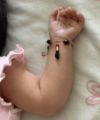Evil eye facts for kids
The evil eye is an old belief found in many cultures around the world. It's the idea that a harmful look from someone can cause bad things to happen. This might include injury, bad luck, or misfortune for the person who receives the look. People often believe this look comes from someone who is very envious or jealous of another.
Contents
What is the Evil Eye?
The evil eye is a powerful gaze that is thought to bring bad luck or harm. It's not just a mean look, but one believed to carry a hidden power. Many cultures believe this look can cause illness, accidents, or even death. It's often linked to feelings like envy or jealousy. If someone is very jealous of your success or happiness, they might unknowingly give you the evil eye.
Where Does This Belief Come From?
The idea of the evil eye is very old. It has been around for thousands of years. Ancient civilizations in places like Greece and Rome believed in it. It is also found in many parts of the Middle East, Africa, and Asia. Even today, many people in these regions still believe in its power. The belief often comes from a fear of envy from others.
How Does the Evil Eye Work?
People believe the evil eye can work in different ways. Sometimes, it's thought to be an accidental curse. This happens when someone feels strong envy. They might not even mean to cause harm. Other times, it's believed to be a deliberate curse. This is when someone actively tries to hurt another with their gaze. The harm can range from small annoyances to serious problems.
Signs of the Evil Eye
People who believe in the evil eye often look for signs. These signs might include sudden illness without a clear cause. Other signs could be bad luck that keeps happening. For example, if a healthy person suddenly feels weak, some might blame the evil eye. If a business suddenly fails, it could also be seen as a sign.
Protecting Against the Evil Eye
Many cultures have developed ways to protect themselves from the evil eye. These protections often involve special objects or rituals. The goal is to ward off the harmful gaze. These methods are meant to deflect the bad energy.
Amulets and Charms
One common way to protect against the evil eye is by using amulets. An amulet is a charm worn or carried for protection. The most famous evil eye amulet is the nazar. This is a blue glass bead shaped like an eye. It is very popular in Turkey and Greece. People believe the nazar looks back at the evil eye. It then sends the bad energy away.
Other Protective Objects
Many other objects are used for protection. The Hamsa hand is another popular symbol. It is a hand-shaped amulet with an eye in the palm. It is used in the Middle East and North Africa. In Italy, people might wear a cornicello. This is a horn-shaped charm. Some cultures also use specific colors, like blue, for protection.
Rituals and Practices
Besides objects, people also use rituals to ward off the evil eye. Some might say special prayers or blessings. Others might perform small ceremonies. For example, in some cultures, people might spit three times (without actual spit) to break a curse. These practices are meant to cleanse bad energy.
Everyday Protections
People also use simple, everyday actions. They might avoid showing off their wealth or happiness too much. This is to prevent others from becoming envious. Parents might put a small evil eye charm on their baby's clothes. This is to protect the child from harm. These actions are part of daily life for many.
The Evil Eye in Different Cultures
The belief in the evil eye is widespread. It appears in many different forms around the world. Each culture has its own unique traditions.
Mediterranean and Middle East
In the Mediterranean and Middle East, the evil eye is a very strong belief. Countries like Turkey, Greece, and Egypt have many traditions related to it. The nazar amulet is a common sight there. People hang them in homes, cars, and businesses. They are also given as gifts to newborns.
Europe
In parts of Europe, especially Italy and Spain, the evil eye is also recognized. In Italy, it's called malocchio. People use gestures like the corna (horned hand sign) to ward it off. In Spain, it's known as mal de ojo. People might use red ribbons or specific prayers for protection.
Other Regions
Beliefs similar to the evil eye exist in India, parts of Africa, and even some parts of Latin America. While the names and specific customs may differ, the core idea remains the same. It is the belief that a jealous gaze can cause harm. This shows how universal the fear of envy can be.
Is the Evil Eye Real?
For many people, the evil eye is a very real threat. They truly believe it can cause harm. For others, it is a superstition or a cultural tradition. Scientists and doctors do not believe in the evil eye. They look for physical or psychological reasons for problems. However, the belief still plays a big role in many societies. It shapes how people interact and protect themselves.
Images for kids
-
Nazars, charms used to ward off the evil eye.
See also
 In Spanish: Mal de ojo para niños
In Spanish: Mal de ojo para niños












